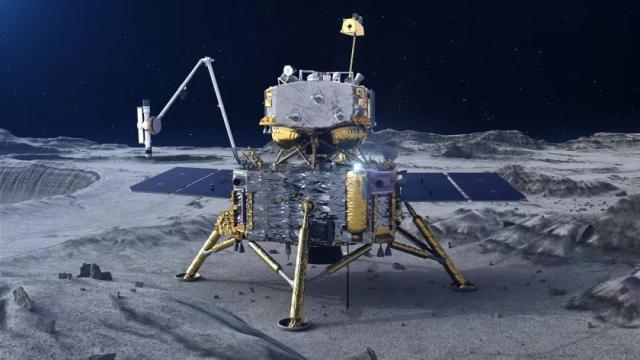Two years ago, China’s Chang’e 5 mission made history by returning lunar samples to Earth for the first time in more than 40 years. The mission’s successor, Chang’e 6, is not only designed to return a second batch of samples from the far side of the Moon — a feat never attempted before — it will also be bringing four payloads along for the ride.
The Chang’e 6 mission is scheduled to launch from China’s coastal Wenchang spaceport in 2025 on board a Long March 5 rocket. Unlike its predecessor, which landed on the near side of the Moon, Chang’e 6 will head to the lunar south pole region on the far side (the side of the Moon that never faces Earth) for its sample collection duties.
In 2018, the China National Space Administration (CNSA) put out a call to international partners seeking to hitch a ride on the trip. Out of 20 proposals, the space agency selected four to include in its Chang’e 6 mission, namely payloads from France, Italy, Sweden, and Pakistan, CNSA revealed in a press release.
The French space agency CNES will contribute the DORN (Detection of Outgassing Radon) instrument, which is designed to measure concentrations of radon on the Moon, and it will do so by observing the gas as it leaks out from the lunar surface. Radon, a noble gas, is possible evidence that the Moon came from the Earth.
Chang’e 6 will also carry a laser retroreflector, a device that reflects concentrated light, from Italy’s National Institute for Nuclear Physics-Frascati National Labs. The device will be used to measure the distance between Earth and the Moon.
The Negative Ions at the Lunar Surface instrument, also to be deployed by the Chang’e 6 lander, will measure solar winds that reflect from the lunar surface upon reaching the Moon. This instrument is being developed by the Swedish Institute for Space Physics.
The ICUBE-Q cubesat from Pakistan is also coming along for the ride, and it’s designed to detect traces of water-ice on the lunar surface.
Along with its payloads, Chang’e 6 is gearing up for an even more challenging mission than its predecessors. The lander is targeting the Moon’s South Pole-Aitken (SPA) basin, a massive impact crater that may be one of the oldest to form on the Moon. The lander will collect samples from the basin and place them in an ascent vehicle that will be launched into lunar orbit. The vehicle will then dock with an orbiter, which will place the samples in a capsule headed for Earth. Should the mission succeed, it’ll be the first to return surface samples from the Moon’s far side.
China is making headway with its space program, a good portion of which is focused on building a base on the Moon. The Chinese space agency already has plans for Chang’e 7 and 8, which will be focused on testing the technologies necessary to build a lunar science base.
It’ll be interesting to see how China’s plans pan out against NASA’s own Artemis program, which is also seeking to build a base for astronauts on the Moon.
More: Chinese Rocket Stage Now a Cloud of Orbital Debris After Disintegrating in Space
